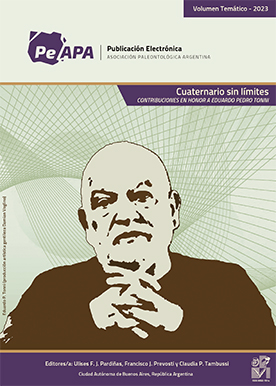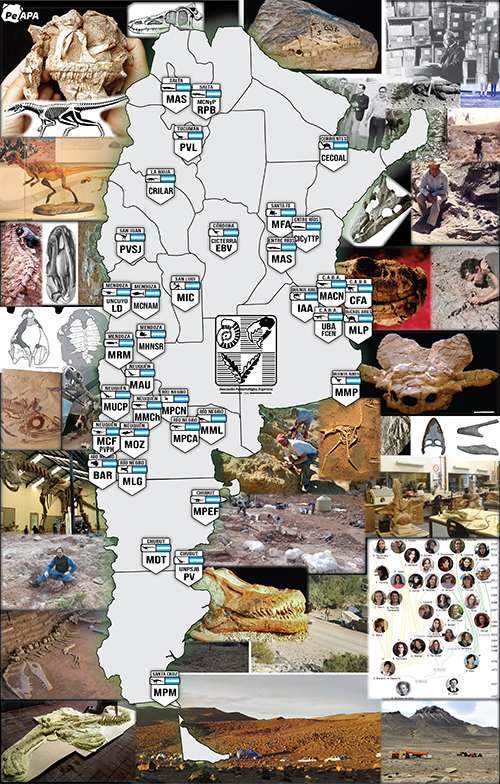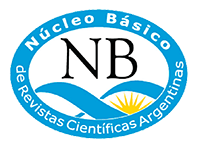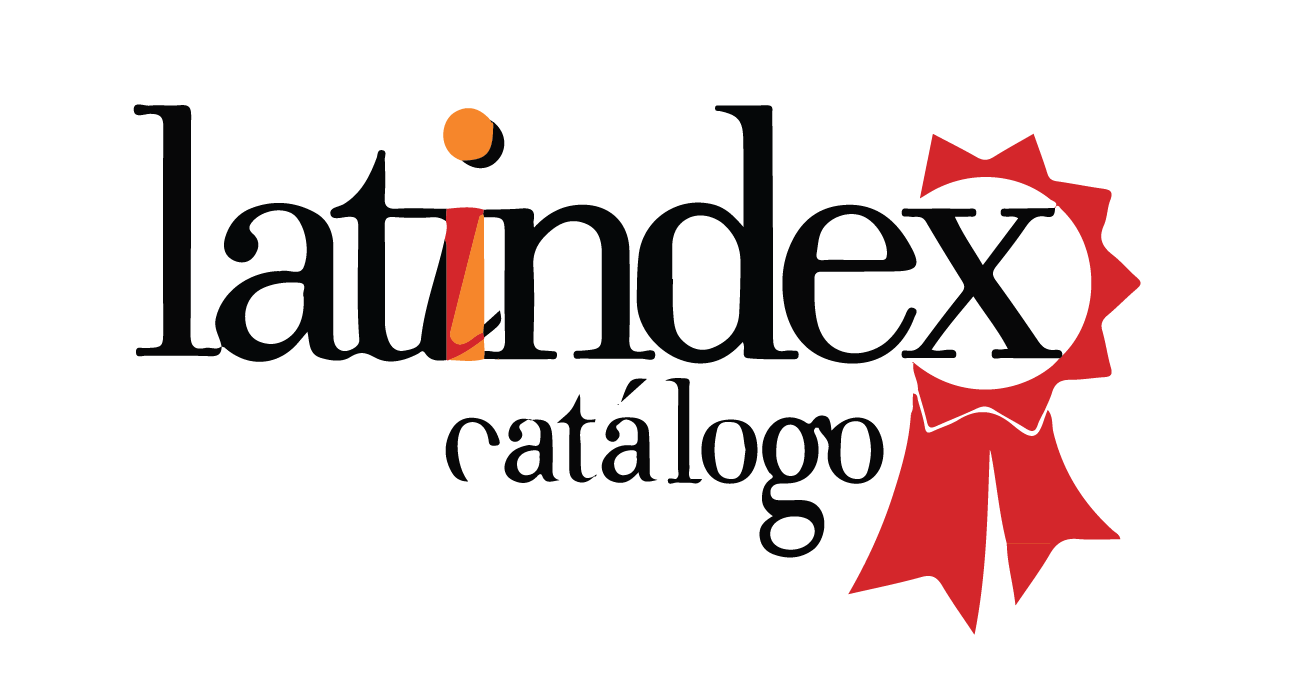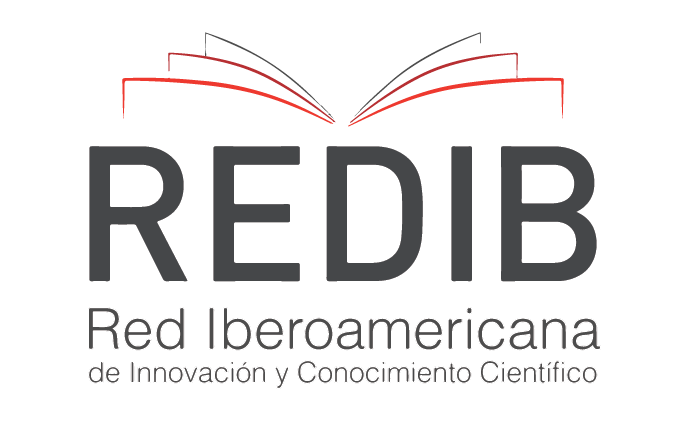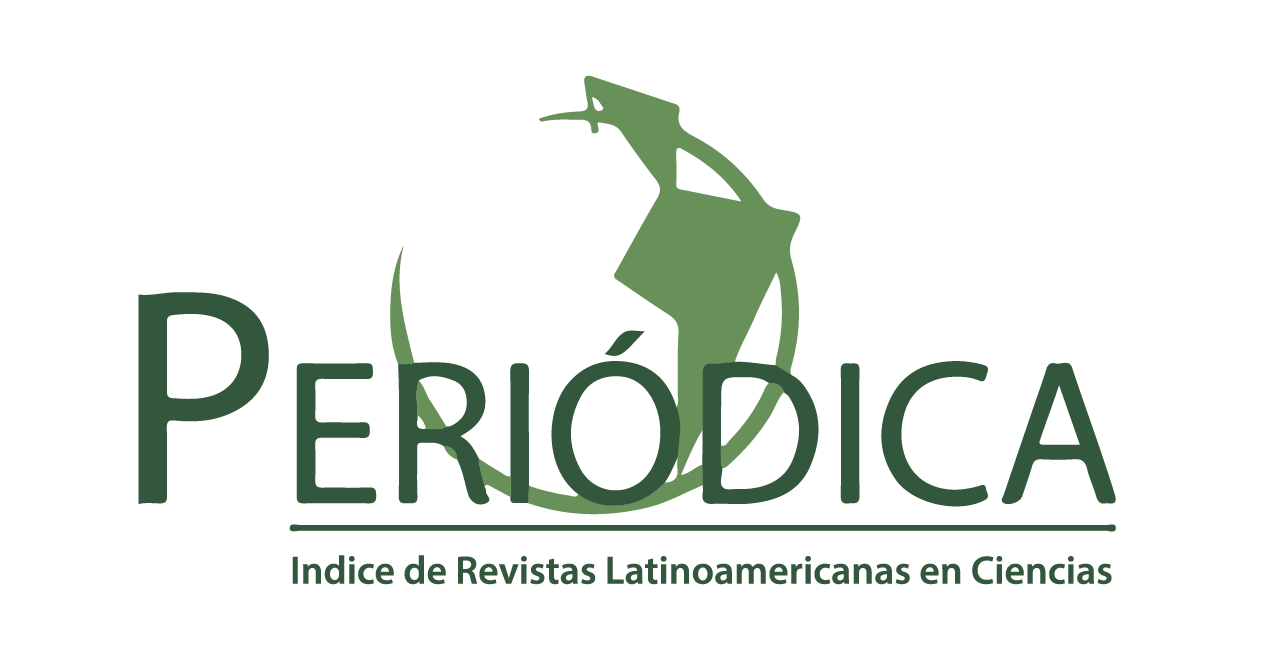THE STUDY OF CONTINENTAL REPTILES IN THE MUSEO DE LA PLATA: HISTORY, LEADING PLAYERS AND CURRENT LINES OF RESEARCH
DOI:
https://doi.org/10.5710/PEAPA.14.05.2021.354Keywords:
Museo de la Plata, Paleoherpetology, Archosauromorphs, Dinosaurs, Crocodiles, Turtles, SquamatesAbstract
The Museo de La Plata has a long history in the study of continental fossil reptiles, represented by dinosaurs, crocodiles, turtles and squamates. The studies of these groups date back to the end of the 19th century, in all cases driven mainly by the pioneering studies of Florentino Ameghino, Santiago Roth, Richard Lydekker and Arthur Smith Woodward. Such studies extend throughout the 20th century, although sporadically. During the first half of the 20th century, studies on continental forms were scarce, highlighting those of Frederick von Huene and Ángel Cabrera. In the 60’s two important events occur. Firstly, Rodolfo Casamiquela made several expeditions to Patagonia, increasing notably the knowledge on mesozoic paleoherpetofauna, hosting the collections at Museo de La Plata. Secondly, the vision of Rosendo Pascual, professor and head of the División Paleontología de Vertebrados, who encouraged young applicants to study amphibians, reptiles and birds by the end of the 60’s, namely, Ana Maria Báez, Zulma Brandoni de Gasparini and Eduardo P. Tonni, respectively. All of them left a legacy behind, represented today by their disciples that continue the research on those clades. Already at the beginning 21st century, lines of research derived from the legacy of Gasparini have a permanent place of work in the institution, studying the anatomy, phylogenetic relationships and paleobiology of continental South American archosaurs. Such lines are focused on pseudosuchians and sauropodomorph dinosaurs, led by Paula Bona, Julia Desojo and Alejandro Otero.
References
Albino, A.M. 1987. Un nuevo Boidae (Reptilia: Serpentes) del Eoceno temprano de la provincia del Chubut, Argentina. Ameghiniana 24: 61–66.
Albino, A.M. 1989. [Los Booidea (Reptilia: serpientes) extinguidos del territorio argentino. Tesis Doctoral. Facultad de Ciencias Naturales y Museo, Universidad Nacional de La Plata, La Plata, 311 p. Inédita.]
Albino, A.M. 1993. Snakes from the Paleocene and Eocene of Patagonia (Argentina): Paleoecology and coevolution with Mammals. Historical Biology 7: 51–69.
Albino, A.M. 2007. Lepidosauromorpha. En: Z. Gasparini, L. Salgado, y R.A. Coria (Eds.), Patagonian Mesozoic Reptiles. Indiana University Press, Indiana, p. 87–115.
Albino, A.M. 2008. Lagartos iguanidos del Colhuehuapense (Mioceno Temprano) de Gaiman (provincia de Chubut, Argentina). Ameghiniana 45: 775–782.
Albino, A.M. y Brizuela, S. 2015. Avances en el conocimiento de los reptiles escamosos fósiles continentales de América del Sur. En: M. Fernández y Y. Herrera (Eds.), Reptiles Extintos - Volumen en Homenaje a Zulma Gasparini. Publicación Electrónica de la Asociación Paleontológica Argentina 15: 31–39.
Ameghino, F. 1882. Catálogo explicativo de las colecciones de Antropología, prehistoria y paleontología de Florentino Ameghino. Catálogo de la Sección de la Provincia de Buenos Aires en la Exposición Continental Sud Americana. Anexo A: 35–42.
Ameghino, F. 1897. Mammiféres crétacés de l’Argentine (Deuxième contribution à la connaissance de la fauna mammalogique de couches à Pyrotherium). Boletin Instituto Geográfico Argentino 18: 406–521.
Ameghino, F. 1898. Sinopsis geológico-paleontológica. En: A.J. Torcelli, (Ed.), Segundo Censo de la República Argentina, Tomo 1, Parte 3 (Territorio), Taller de Impresiones Oficiales, Buenos Aires, p. 111–255.
Ameghino, F. 1899. Sinopsis geológica paleontológica. Suplemento (adiciones y correcciones). Censo Nacional, La Plata: 1–13.
Ameghino, F. 1906. Les formations sédimentaires du Crétacé supérieur et du Tertiaire de Patagonie avec un parallèle entre leurs faunes mammalogiques et celles de l’ancien continent. Anales del Museo Nacional de Buenos Aires 15: 1–568.
Barrios, F., Bona, P., Paulina-Carabajal, A. y Gasparini, Z. 2018. Re-description of the cranio-mandibular anatomy of Notosuchus terrestris (Crocodyliformes, Mesoeucrocodylia) from the Upper Cretaceous of Patagonia. Cretaceous Research, 83: 3–39.
Bona, P. 2004. [Sistemática y biogeografía de las tortugas y los cocodrilos paleocenos de la Formación Salamanca, Provincia de Chubut, Argentina. Tesis Doctoral, Facultad de Ciencias Naturales y Museo. Universidad Nacional de La Plata, La Plata, Argentina, 159 p. Inédita.].
Bona, P. 2006. Paleocene (Danian) chelid turtles from Patagonia, Argentina: taxonomic and biogeographic implications. Neues Jahrbuch für Geologie und Palaeontologie 241: 303–323.
Bona, 2007. Una nueva especie de Eocaiman Simpson (Crocodylia,Alligatoridae) del Paleoceno Inferior de Patagonia. Ameghiniana 44: 435–445.
Bona, P. y de la Fuente, M.S. 2005. Phylogenetic and paleobiogeographic implications of Yaminuechelys maior (Staesche, 1929) new comb. A large long-necked chelid turtle from the Early Paleocene of Patagonia. Journal of Vertebrate Paleontology 25: 569–582.
Bona, P. y Barrios, F. 2015. The Alligatoroidea of Argentina: an update of its fossil record. En: M. Fernández y Y. Herrera (Eds.), Reptiles Extintos - Volumen en Homenaje a Zulma Gasparini. Publicación Electrónica de la Asociación Paleontológica Argentina 15: 143–158.
Bona, P., de la Fuente, M.S. y Reguero, M. 2010. New fossil turtle remains from the Eocene of the Antarctic Peninsula. Antarctic Science 22: 531–532.
Bona, P., Riff, D., y Gasparini, Z.B. 2013.Late Miocene crocodylians from northeast Argentina: new approaches about the austral components of the Neogene South American crocodilian fauna. Earth and Environmental Science Transactions of the Royal Society of Edinburgh 103: 551–570.
Bona, P., Ezcurra, M.D., Barrios, F. y Fernandez Blanco, M.V. 2018 A new Palaeocene crocodylian from southern Argentina sheds light on the early history of caimanines. Proceedings of The Royal SocietyB 285: 20180843.
Bonaparte, J.F. y Vince, M. 1979. El hallazgo del primer nido de dinosaurios triásicos (Saurischia, Prosauropoda), Triásico Superior de Patagonia, Argentina. Ameghiniana 76: 173–782.
Bonaparte, J.F. 1991. Los vertebrados fósiles de la Formación Río Colorado, de la ciudad de Neuquén y cercanías, Cretácico Superior, Argentina. Revista del Museo Argentino de Ciencias Naturales “Bernardino Rivadavia” 4: 16e123.
Brizuela, S. 2010. [Los lagartos continentales fósiles de la Argentina (excepto Iguania). Tesis Doctoral, Facultad de Ciencias Naturalesy Museo, Universidad Nacional de La Plata, La Plata, 408 p.Inédita.].
Brizuela, S. y Albino, A.M. 2008. Tupinambine teiids from the middle Miocene of north-western Patagonia (Argentina). Amphibia-Reptilia 29: 425–431.
Brochu, C.A., 2011 Phylogenetic relationships of Necrosuchus ionensis Simpson, 1937 and the early history of caimanines. Zoological Journal of The Linnean Society 163: 228–256.
Broin, F. de, y de la Fuente, M.S. 1993. Les tortues fossiles d’Argentine: synthèse. Annales de Paléontologie 79: 169–232.
Burmeister, G. 1885. Examen crítico de los mamíferos y los reptiles denominados por Don Augusto Bravard. Anales del Museo Público de Buenos Aires 3: 95–173.
Cabrera, A. 1947. Un saurópodo nuevo del Jurásico de Patagonia, Notas del Museo de La Plata. Paleontología 12: 1–17.
Casamiquela, R.M. 1964. Estudios icnológicos. Problemas y métodos de la icnología con aplicación al estudio de pisadas mesozoicas (Reptilia, Mammalia) de la Patagonia. Colegio Industrial Pío IX, Buenos Aires, Argentina, 229 p.
Casamiquela, R.M. 1980. La presencia del género Plateosaurus (Prosauropoda) en el Triásico superior de la Formación El Tranquilo, Patagonia. Actas del II Congreso Argentino de Paleontología y Bioestratigrafía y I Congreso Latinoamericano de Paleontología 1: 113–758.
Cerda, I.A., Carabajal, A.P., Salgado, L., Coria, R.A., Reguero, M., Tambussi, C., Molly, J., 2012. The first record of a sauropod dinosaur from Antarctica. Naturwissenschaften 99: 83–87.
Cione, A.L., Casciotta, J.R., Azpelicueta, M.M., Barla, M.J. y Cozzuol, M.A. 2005. Peces marinos y continentales del Mioceno del área Mesopotámica Argentina, procedencia estratigráfica y relaciones biogeográficas. Miscelánea INSUGEO 12: 49–64.
Cope, E.D. 1870. Seventh contribution to the herpetology of tropical America. Proceedings of the American Philosophical Society 11: 147–169.
de la Fuente, M.S. 1988. [Las tortugas Chelidae (Pleurodira) y Testudinidae (Cryptodira) del Cenozoico argentino. Tesis Doctoral, Facultad de Ciencias Naturales y Museo, Universidad Nacional de la Plata, La Plata, Argentina, vol. 1: 270 p., vol. 2: 64 pl. Inédita.].
de la Fuente, M.S.1992. Las tortugas Chelidae del Terciario superior y Cuaternario del territorio argentino. Ameghiniana 29: 211–299.
de la Fuente M.S. 1997. Las tortugas terrestres gigantes del Mioceno tardío-Plioceno del territorio argentino. Stvdia Geologica Salmanticensia 33: 91–120
de la Fuente, M.S., Santillana, S.N. y Marenssi, S. 1995. An Eocene leatherback turtle (Cryptodira: Dermochelyidae) from Seymour Island, Antarctica. Stvdia Geologica Salmanticensia 31: 17–30.
de la Fuente, M. y Bona, P. 2002. Una nueva especie de Hydromedusa Wagler, 1830 (Pleurodira, Chelidae) del Paleógeno de Patagonia. Ameghiniana 39: 77–83.
de la Fuente M. S. y Sterli, J. 2015. Estado del conocimiento de las tortugas extintas del territorio argentino: una perspectiva histórica. Asociación Paleontológica Argentina, Publicación Electrónica 15: 1–16.
de la Fuente, M.S., Lapparent de Broin, F. de, y Manera de Bianco, T. 2001. The oldest and first nearly complete skeleton of a chelid, of the Hydromedusa group (Chelidae, Pleurodira), from the Upper Cretaceous of Patagonia. Bulletin de la Société Geologique de France 172: 237–244.
de la Fuente, M.S., Zacarias, G.G. Vlachos, E. 2018. A review of the fossil record of the South American turtles of the clade Pan-Testudinoidea. Bulletin of the Peabody Museum of Natural History Yale University 59: 269–286.
Desojo, J.B., Ezcurra, M.D. 2011. A reappraisal of the taxonomic status of Aetosauroides scagliai (Archosauria, Aetosauria) specimens from the Late Triassic of South America and their proposed synonymy with Stagonolepis. Journal of Vertebrate Paleontology, 31: 596–609.
De Valais, S. 2011. Revision of dinosaur ichnotaxa from the La Matilde Formation (middle Jurassic), Santa Cruz Province, Argentina. Ameghiniana 48: 28–42.
Estes, R., Frazzetta, T.H. y Williams, E.E. 1970. Studies on the fossil snake Dinilysia patagonica Smith Woodward: Part I. Cranial morphology. Bulletin of the Museum of Comparative Zoology 140: 25–74.
Fernández, M.S., 1988. [Las Testudinidae (Reptilia: Chelonii) argentinas: osteología, sistemática y distribución geográfica. Tesis doctoral, Universidad Nacional de La Plata, 276 p. Inédita.].
Fitzinger, L. 1843. Systema Reptilium. Fasciculus primus, Amblyglossae. Wien, 106 pp.
Fiorelli, L.E., Calvo, J. 2008. New remains of Notosuchus terrestris Woodward, 1896 (Crocodyliformes: Mesoeucrocodylia) from the Late Cretaceous of Neuquén, Patagonia, Argentina. Arquivos do Museu Nacional Rio de Janeiro 66: 83–124.
Garrido, A.C. 2010. Paleoenvironment of the Auca Mahuevo and Los Barreales sauropod nesting sites (Late Cretaceous, Neuquén Province, Argentina). Ameghiniana 47: 99–106.
Gasparini, Z. 1968. Nuevos restos de Rhamphostomopsis neogaeus (Burm.) Rusconi 1933 (Reptilia, Crocodilia) del “Mesopotamiense” (Plioceno medio-superior) de Argentina. Ameghiniana 5: 299–311.
Gasparini, Z.B., 1971. Los Notosuchia del Cretácico de América del Sur como un nuevo Infraorden de los Mesosuchia (Crocodilia). Ameghiniana 8: 83–103.
Gasparini, Z. 1981. Los Crocodylia Fósiles de la Argentina. Ameghiniana 18: 177–205
Gasparini, Z. 1985. Un nuevo cocodrilo (Eusuchia) Cenozoico de América del Sur. MME-DNPM Série Geologia Paleontologia, Estratigrafía 2: 51–53.
Gasparini, Z.B. y Bufettaut, E.1980. Dolichochampsa minima, n. g. n. sp., a representative of a new family of eusuchian crocodiles from the Late Cretaceous of Northern Argentina. Neues Jahrbuch für Mineralogie - Abhandlungen 5: 257–271.
Huene, F. Von., 1929. Los Saurisquios y Ornitisquios del Cretáceo Argentino. Museo de la Plata, Anales Vol. 3, 194 pp.
Jalfin, G.A. y Herbst, R. 1995. La flora triásica del grupo El Tranquilo, provincia de Santa Cruz (Patagonia). Estratigrafia. Ameghiniana 32: 211–229.
Lydekker, R. 1893. The dinosaurs of Patagonia, Anales Museo de La Plata Vol. 2., p. 1–14.
Maniel, I., de la Fuente, M.S. 2016. A Review of the Fossil Record of Turtles of the Clade Pan-Chelidae. Bulletin of the Peabody Museum of Natural History Yale University 57: 191–227.
Moreno, F.P. 1889. Breve reseña de los progresos del Museo de La Plata durante el segundo semestre de 1888. Bulletin del Museo de La Plata 2: 1–44.
Otero, A., Pol, D. 2013. Postcranial anatomy and phylogenetic relationships of Mussaurus patagonicus (Dinosauria, Sauropodomorpha). Journal of Vertebrate Paleontology 33: 1138–1168.
Otero, A. y Gasparini, Z. 2014. The history of the cast skeleton of Diplodocus carnegii Hatcher, 1901, at the Museo de la Plata, Argentina. Annals of the Carnegie Museum 82: 291–304.
Otero, A., Allen, V., Pol., D. y Hutchinson, J.R. 2017. Forelimb muscle and joint actions in Archosauria: insights from Crocodylus johnstoni (Pseudosuchia) and Mussaurus patagonicus (Sauropodomorpha). PeerJ 5: e3976.
Otero, A., Cuff, A., Allen, V., Sumner-Rooney, L., Pol., D. y Hutchinson, J.R. 2019. Ontogenetic changes in the body plan of the sauropodomorph dinosaur Mussaurus patagonicus reveal shifts of locomotor stance during growth. Scientific Reports 9: 7614.
Pol, D., 2005.Postcranial remains of Notosuchus terrestris (Archosauria: Crocodyliformes) from the Upper Cretaceous of Patagonia, Argentina. Ameghiniana 42: 21–38.
Rage, J.C. y Albino, A.M. 1989.Dinilysia patagonica (Reptilia, serpents): materiel vertebral additionnel du Crétacé supérieur d’Argentine. Etude complémentaire des vertèbres, variations intraspécifiques et intracolumnaires. Neues Jahrbuch für Geologie and Paläontologie 7: 433–447.
Reig, O.A. 1959. Primeros datos descriptivos sobre nuevos reptiles arcosaurios del Triásico de Ischigualasto (San Juan, Argentina). Revista de laAsociación Geológica Argentina 13: 257–270.
Reig, O.A. 1963. La presencia de dinosaurios sauriquios en los “Estratos de Ischigualasto” (Mesotriáscio Superior) de las Provincias de San Juan y La Rioja (República Argentina). Ameghiniana 3 (1): 3–20
Rhodin, A.G.J., Thomson, S., Georgalis, G, Karl, .H.-V., Danilov, I.G., Takahashi, A., de la Fuente, M.S., Bourque, J.R., Delfino, M., Bour, R., Iverson, J.B., Shaffer H. B. y van Dijk, P.P. 2015. Turtles and tortoises of the world during the rise and global spread of humanity: first checklist of extinct Pleistocene and Holocene chelonians. En: A.G.J. Rhodin, P.C.H. Pritchard, P.P. van Dijk, R.A. Saumure, K.A. Buhlmann, J.B. Iverson, R.A. Mittermeier, (Eds.), Conservation Biology of Freshwater Turtles and Tortoises: A Compilation Project of the IUCN/SSC Tortoise and Freshwater Turtle Specialist Group. Chelonian Research Monographs 5:1–66.
Romer, A.S. 1966. The Chanares (Argentina) Triassic reptile fauna: I. Introduction. Breviora 247: 1–14.
Rusconi, C. 1933. Observaciones criticas sobre reptiles Terciarios de Paraná (Familia Alligatoridae). Revista de la Universidad Nacional de Córdoba 20: 1–52.
Salas-Gismondi, R. Flynn, J.J., Baby, P., Tejada-Lara, J.V., Wesselingh, F.P. y Antoine, P-O. 2016. A Miocene hyperdiverse crocodilian community reveals peculiar trophic dynamics in proto-Amazonian mega-wet lands. Proceedings of The Royal SocietyB 282: 20142490.
Salgado, L. 2007. Patagonia and the Study of Its Mesozoic Reptiles: A Brief History. En: Z. Gasparini, L. Salgado y R.A. Coria (Eds.), Patagonian Mesozoic Reptiles. Indiana University Press Bloomington & Indianapolis, p. 1–28.
Salgado, L. y Gasparini, Z. 2006. Reappraisal of an ankylosaurian dinosaur from the Upper Cretaceous of James Ross Island (Antarctica). Geodiversitas 28: 119–135.
Scanferla, C.A. 2010. [El origen y evolución temprana de las serpientes. Tesis Doctoral, Facultad de Ciencias Naturales y Museo, Universidad Nacional de La Plata, 529 p. Inédita.].
Simpson, G.G. 1933. A new crocodilian from the Notostylops Beds of Patagonia. American Museum Novitates 623: 1–9.
Simpson, G.G. 1937. An ancient eusuchian crocodile from Patagonia. American Museum Novitates 965: 1–20.
Smith, R.M., Marsicano, C., Pol, D. y Mancuso, A. 2014. Ichnology of sauropodomorph nests from Patagonia indicates early Jurassic origin of herd-living and breeding site fidelity. 4th International Palaeontological Congress, Mendoza, Argentina, 227.
Staesche, K. 1929. Schildkrötenreste aus der oberen Kreide Patagoniens. Palaeontographica 72: 103–112.
Sterli, J., de la Fuente, M.S. 2011a. Re-description and evolutionary remarks on the Patagonian horned turtle Niolamiaargentina Ameghino, 1899 (Testudinata; Meiolaniidae). Journal of Vertebrate Paleontology 31: 1210–1229.
Sterli, J. y de la Fuente, M.S. 2011b. A new turtle from the La Colonia Formation (Campanian–Maastrichtian), Patagonia, Argentina, with remarks on the evolution of the vertebral column in turtles. Palaeontology 54: 63–78.
Sterli, J., de la Fuente, M.S. y Cerda, I. 2013. A new species of Meiolaniform turtle and revision of the Late Cretaceous Meiolaniformes of South America. Ameghiniana 50: 240–256.
Triviño, L.N. 2018. [Serpientes Cretácicas y paleógenas de Argentina. Paleoecología y Paleoclimas. Tesis Doctoral. Facultad de Ciencias Naturales y Museo. Universidad Nacional de La Plata, La Plata, 203 p.Inédita.].
Triviño, L.N., Albino, A.M., Dozo, M.T. y Williams, J.D. 2018. First natural endocranial cast of a fossil snake (Cretaceous of Patagonia, Argentina). The Anatomical Record 301: 9–20.
Wagler, J. 1830. Natürliches System der Amphibien, mit Vorangehander Classification der Säugthiere und Vogel. J G Cotta’schen Buchhandlung, München, 354 p.
Wilson, J. y Upchurch, P. 2003. A revision of Titanosaurus Lydekker (Dinosauria – Sauropoda), the first dinosaur genus with a ‘Gondwanan’ distribution. Journal of Systematc Palaeontology 1: 125–160.
Woodward, A.S., 1896. On two Mesozoic crocodilians (Notosuchusgenus novum) and (Cynodontosuchusgenus novum) from the red sandstones of the territory of Neuquen (Argentine Republic). Anales del Museo de La Plata 4: 1–20.
Woodward, A.S. 1901. On some extinct reptiles from Patagonia of the generaMiolania, Dinilysia, and Genyodectes. Proceedings of the Zoological Society of London 1901: 169–184.
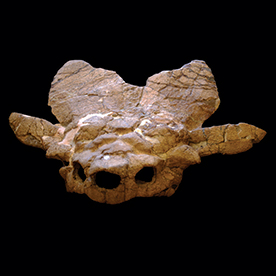
Additional Files
Published
Issue
Section
License
Copyright (c) 2022 Alejandro Otero, Paula Bona, Marcelo Saúl de la Fuente, Julia Desojo

This work is licensed under a Creative Commons Attribution-NoDerivatives 4.0 International License.

Authors retain copyright and grant the journal right of first publication with the work simultaneously licensed under a CC Attribution-NonCommercial 4.0 that allows others to share the work with an acknowledgement of the work's authorship and initial publication in this journal.







